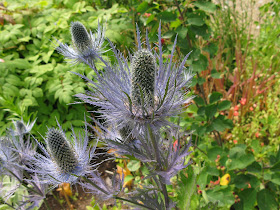This odd blue-grey brush-like perennial flower is Eryngium alpinum, which was planted in 2007 and bloomed for the first time this year. It is almost 3 feet (90 cm) tall and fits in well in the middle of a raised bed.

While not a perennial, this little poppy in the alpine garden self-seeds and the two plants I started with last year left some lovely offspring that are blooming now in early August. This Papaver miyabeanum "Pacino" has a sulphur-colored flower and is known as the Japanese poppy.

Once again, I conclude that the Papaver rhoeas (corn poppies, Shirley poppies) give me a boost of garden-happiness. To keep some in a vase, I sealed the stems to prevent the latex from dripping out, a tip which I had read on the internet. I burned the bottom of the stem with the flame from a BBQ lighter for about 10 seconds. It worked better than I had imagined and the flowers looked great for about 3 days.
Papaver rhoeas as a cut flower:

Here is the view of the center raised bed from our house:

Center raised bed, with some lilies yet to bloom and Papaver rhoeas blooming on the right:

Does burning the stems work for all poppies, or just Papaver rhoeas?
ReplyDeleteA boost of garden-happiness indeed! Poppies are a cure for many things. I hope you'll keep having the E. alpinum come back; mine has disappeared but I have many E. planum, and they're gloriously in bloom.
ReplyDeleteA vicarious boost of garden happiness for all of us who enjoy your photographs.
ReplyDeleteTo Karen, yes, burning the stems is good for all poppies. Here's a page Google popped up for me with conditioning tips for all sorts of flowers:
http://www.belmontgardenclub.info/Categories/FlowerArranging.html
I love the look of sea-holly but don't think I've ever seen it in Sydney; it might not like our climate. Love the beautiful shades on the poppies too!
ReplyDelete